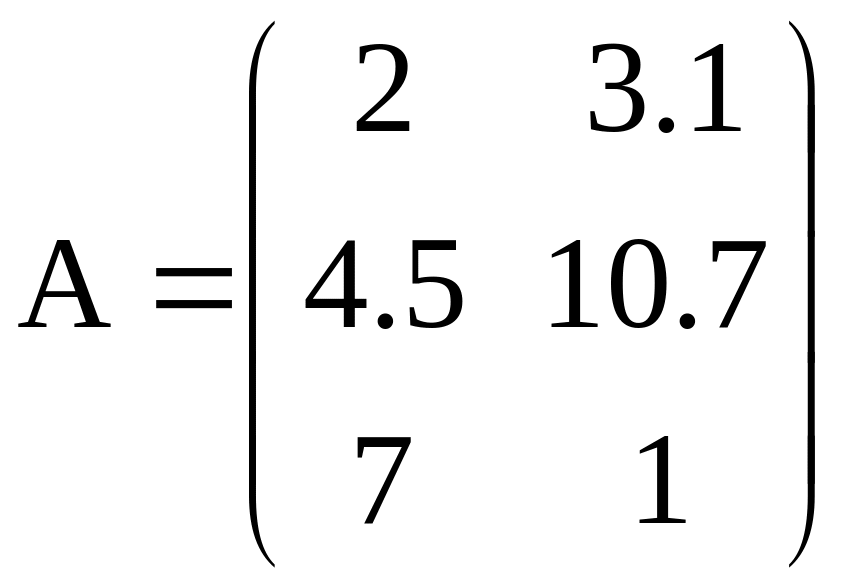
- •Introduction
- •Laboratory Work 1 computing of polynomial value according to the horner’s method
- •For mating variants:
- •Laboratory Work 2 primitive operations with matrices
- •In the first case the result will be the vector –column with the elements
- •Laboratory Work 3 solution of the systems of linear equations with real coefficients
- •Table 3.1 Scheme Parametres
- •Laboratory Work 4 solution of the linear equation systems with the complex coefficients
- •If such a programme is available to compute the value of the variable
- •Laboratory Work 5 matrix inversion
- •The matrix
- •Laboratory Work 6 matrix determinant computation
- •Laboratory Work 7 matrix inversion
- •The equation
- •Laboratory Work 8
- •Laboratory Work 9 Refinement of the roots of transcendental and algebraic equations
- •Iterations are stopped if the condition
- •Laboratory Work 10 solution of the non-linear equation systems
- •If the initial approximations of the roots are
- •The iterations are stopped if the condition
- •Laboratory work 11 numerical soultion of linear differential equations
- •Laboratory Work 12 іinterpolation
- •Laboratory Work 13 approximation done by the least-squares method
- •Laboratory Work 14 numerical integration
- •Laboratory Work 15 harmonic analysis and synthesis of the periodical functions
- •Laboratory Work 16
- •References
- •Contents
In the first case the result will be the vector –column with the elements
![]() (2.4)
(2.4)
(і=1, 2,..., m) , and in the second case – the vector- line with the elements
![]() .
(2.5)
.
(2.5)
According to the term the matrix scalar product only the square matrix can be exponentiated into the integral positive rate:
А![]() k=((АА)А)…А)
(2.6)
k=((АА)А)…А)
(2.6)
k- factors
2.1.3 Matrix Transposition
If
to
replace
the
lines
of
the
matrix
A
with
the
size
mn
by the corresponding columns, we will get the matrix А![]() with
the size nm
which is called the transposed one relative to the matrix A.
with
the size nm
which is called the transposed one relative to the matrix A.
Thus,
ijT= ji
(i=1,2,…,n; j=1,2,…,m).
2.1.4 Matrix Norms
The norm of the matrix A=[aij] is the real number ||A|| which meets the following requirements:
- ||A||≥0 (and ||A=0|| only when А=[0]),
||A||=||*||A||, where - the real number (and ||-A||=||A||),
||A||+||B||≥||A+B||,
||AB||||A||*||B||,
||A-B||≥|||B||-||A|||.
The following three norms are considered the easiest to compute :
![]() (2.7)
(2.7)
The maximum sum of the matrix element modules in the lines;
![]() (2.8)
(2.8)
The maximum sum of the matrix element modules in the columns;
![]() (2.9)
(2.9)
Square root of the sum of the squares of the modules of all matrix elements.
2.2 Tasks
Do the operations with matrices according to the phrases given in the table 2.1. The repeated actions should be presented as separate procedures:
 ,
,
![]() ,
,
 ,
,
![]() .
.
Table 2.1
Number of the variant |
Tasks |
1 |
2 |
1 |
Check the correlations:: ||A+C||1 ||A||1+||C||1 |
2 |
||A*B||1 ||A||1*||B||1 |
3 |
||A-C||1 | ||C||1-||A||1 | |
4 |
||A+C||2||A||2+||C||2 |
5 |
||A*B||2||A||2*||B||2 |
6 |
||A-C||2 | ||C||2-||A||2 | |
7 |
||A+C||3||A||3+||C||3 |
8 |
||A*B||3||A||3*||B||3 |
The continuation of the table 2.1 |
|
1 |
2 |
9 |
||A-C||3 | ||C||3-||A||3 | |
10 |
Compute: K=A+C+BT |
11 |
K=B(A+C)+D |
12 |
K=(A-C)*(D*B) |
13 |
K=BT-A-C |
14 |
K=B*A*B |
15 |
L=||A+C||1+||B||1 |
16 |
L=||A||1+||B||2+||C||1 |
17 |
K=C*D+A+C |
18 |
K=B*C*D |
19
|
||A||1 ||AT||1 ||B||1 ||BT||1 |
20 |
K=D*CT*A |
21 |
K=D-B*C-B*A |
22 |
K=AT+CT+B |
23 |
K=(A-C)*B |
24 |
K=C*D-A-C |
